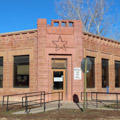Buffalo Gap is a small town on the eastern edge of the Black Hills in Custer County. The site began as a stage stop of the Sidney–Deadwood trail during the 1875–1876 gold rush and developed into an important waystation and supply depot, and development continued even after the gold rush waned. When the railroad reached the Black Hills in 1885, the town of Buffalo Gap was platted about a half-mile south of the old stage stop. By the end of the nineteenth century, as the cattle industry on the nearby plains grew, Buffalo Gap became one of the region’s busiest cattle-shipping points. The livestock pens were east of the commercial district, beyond the railroad depot located at First and Main. Most of the commercial buildings lined Main Street, but also Walnut Street, which ran parallel to Main on the north. These were one- or two-story, wood-frame structures with false fronts concealing flat or gabled rooflines.
The town reportedly had 142 businesses during this period, including twenty-three saloons, seventeen hotels and restaurants, four general stores, four Chinese laundries, hardware and clothing stores, two drugstores, and a bank. The high number of saloons and hotels indicates that the town was frequented by transients, cowboys, and occasionally, outlaws. Buffalo Gap’s boom period came to an end as increasing settlement in the area resulted in fewer cattle ranches, coupled with the years of droughts and blizzards that had reduced the herds. An 1895 fire destroyed much of the central business district.
Only four buildings survived the fire, including an old bank/land office (1886) on the northeast corner of Second and Walnut. It features Italianate detailing on its wooden false-front facade and a canted main entry at the corner, which is framed by pilasters with a pediment and transom window. The building is now the town’s post office. Nearby on Second Street is Clark’s Store (1890), a typical late-nineteenth-century, false-front commercial building with a wood awning, recessed doors, and large display windows. The Wilson Hotel (1892) on Walnut Street, a two-story structure with false front and clapboard siding, was stuccoed at an unknown date and is currently vacant. On the southwest corner of Second and Main is the Gothic Revival Congregational Church (1899), which was moved to this location in 1909. With its projecting tower, louvered belfry, and pyramidal steeple, the church remains one of the tallest structures in town, rivaled only by the taller grain elevator one block east.
Buffalo Gap was never completely rebuilt after the fire, and the town’s many vacant lots indicate the location of the lost businesses. Renewed growth occurred between 1905 and 1915, and most buildings date to this period. The majority are small, single-story, wood-frame structures with false fronts and some Italianate detailing. There are a few notable sandstone buildings, however, demonstrating the adaptation of native stone to the Western vernacular style. A former dry-goods store on the east side of Second Street between Walnut and Main features coursed ashlar stonework on the front and random rubble stonework on the sides; post-holes in front of the building indicate a wooden awning likely extended over the sidewalk. Citizen’s Bank (1910, now City Hall) on the northwest corner of Second and Main is also built of rusticated native sandstone, but offers finer detailing, with inverted U-shaped window and door crowns; a parapet wall above the canted, recessed entry; and a plinth course extending along the south and east walls. The Buffalo Gap Auditorium (1908) at Main and Third streets is a large, two-story, Italianate structure with a stepped parapet. Built to house agricultural fairs and other communal activities, it continues to function as a community center.
Buffalo Gap’s growth and prosperity continued into the 1920s. The construction of the Nolan Grain Elevator in 1926, on the east end of Main Street, indicated the regional shift from cattle ranching to grain farming. Now clad in corrugated metal, the elevator originally had clapboard siding. Unfortunately, the new state highway bypassed the town in the early 1930s and the discontinuance of the railroad spur line in 1938, along with the effects of the Great Depression, caused a rapid near-abandonment of the town’s commercial center. After the railroad completely ceased cattle-shipping operations from Buffalo Gap in 1958, most of the town’s businesses closed for good. The post office, city hall, church, grain elevator, and a few houses remain. As of the 2010 census, the town’s population was 125. Today, most of the buildings are abandoned but the streetscape remains that of a turn-of-the-century western town.
References




